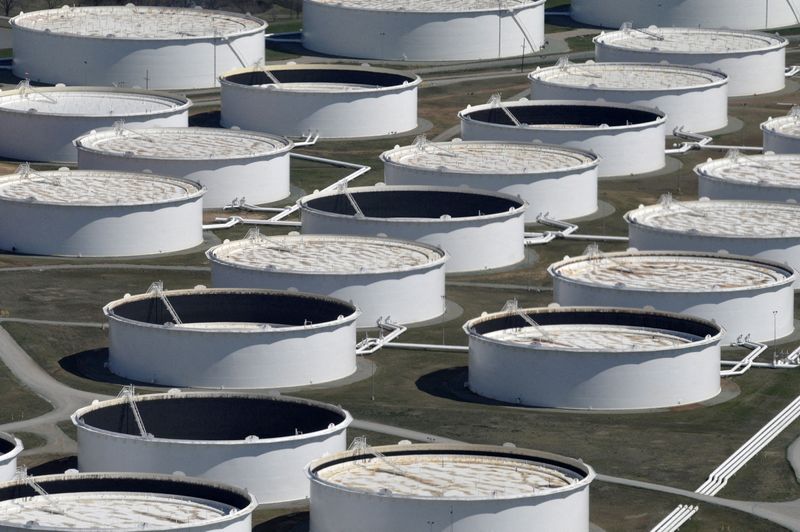Commodities
Oil steadies as Middle East war worries counter demand fears


© Reuters. FILE PHOTO: Crude oil storage tanks are seen from above at the Cushing oil hub, appearing to run out of space to contain a historic supply glut that has hammered prices, in Cushing, Oklahoma, March 24, 2016. REUTERS/Nick Oxford//File Photo
By Natalie Grover
LONDON (Reuters) -Oil benchmark Brent held above $88 on Wednesday as concerns about war escalating in the Middle East offset demand worries stemming from gloomy economic prospects in Europe.
futures were up 11 cents to $88.18 a barrel at 0948 GMT, while U.S. West Texas Intermediate crude futures slipped 5 cents to $83.69 a barrel.
Countries are pushing for a pause or ceasefire in fighting between Israel and Hamas in the Gaza Strip so that humanitarian aid can be delivered to besieged Palestinian civilians.
Meanwhile, U.S. and Saudi Arabia leaders on Tuesday discussed efforts to prevent the conflict from widening to potentially include major oil producer Iran.
Elsewhere in Europe, a slew of recent manufacturing and services activity data has served as a reminder that glum macro-economic indicators from some of the largest economies could dampen demand, said John Evans of oil broker PVM.
The data, he noted, “runs somewhat counter to the idea that oil will be free from bumps to the seasonal demand forecasted for this winter in the Northern Hemisphere.”
Growth indicators from industrial output data to PMI and sentiment readings in recent weeks are all suggesting that the euro zone’s economy is now either stagnating or even shrinking as weak external demand, consumer caution and high interest rates take their toll.
Bank lending across the euro zone came to a near standstill last month, European Central Bank data showed on Wednesday, providing further evidence that the 20-nation bloc was skirting a recession.
However, on the bright side, crude prices could find some support as the top parliament body in China, the world’s biggest oil importer, approved a bill to issue 1 trillion yuan ($137 billion) in sovereign bonds and allow local governments to issue new debt from their 2024 quota to boost the economy.
But demand for in China could be limited as Beijing put a ceiling for its oil refining capacity at 1 billion metric tons by 2025 to streamline its vast oil processing sector and curb carbon emissions.
Falling crude oil stockpiles in the U.S., the world’s biggest oil consumer, are also supportive of prices. U.S. inventories declined unexpectedly by about 2.7 million barrels in the week ended on Oct. 20, according to market sources citing American Petroleum Institute figures on Tuesday.
Analysts polled by Reuters had estimated on average that crude inventories would go up by about 200,000 barrels for the week. [API/S]
U.S. government data on inventories is due later on Wednesday. [EIA/S]
Commodities
Oil prices rise; U.S. crude inventories plunge, Russia-Ukraine truce eyed
Commodities
India’s Reliance to stop buying Venezuelan oil over US tariffs, sources say
Commodities
Oil prices climb on Venezuela supply worries

 Forex3 years ago
Forex3 years agoForex Today: the dollar is gaining strength amid gloomy sentiment at the start of the Fed’s week

 Forex3 years ago
Forex3 years agoUnbiased review of Pocket Option broker

 Forex3 years ago
Forex3 years agoDollar to pound sterling exchange rate today: Pound plummeted to its lowest since 1985

 Forex3 years ago
Forex3 years agoHow is the Australian dollar doing today?

 Cryptocurrency3 years ago
Cryptocurrency3 years agoWhat happened in the crypto market – current events today

 World3 years ago
World3 years agoWhy are modern video games an art form?

 Commodities3 years ago
Commodities3 years agoCopper continues to fall in price on expectations of lower demand in China

 Economy3 years ago
Economy3 years agoCrude oil tankers double in price due to EU anti-Russian sanctions



























